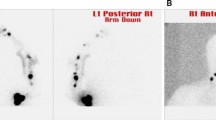Abstract
Background:Harvesting the sentinel lymph node (SLN) is important in the management of patients with primary cutaneous melanoma. Selective sentinel lymphadenectomy (SSL) is generally performed at the time of wide local excision (WLE). The aim of our study was to determine whether delayed SSL is useful in detecting micrometastasis to the regional basin in patients with previous WLE of an extremity melanoma.
Methods:Of 203 patients with a primary melanoma site located on the upper or lower extremity seen at the University of California, San Francisco/Mount Zion Melanoma Center from May 17, 1994, to March 23, 1999, 24 patients had a WLE of their extremity melanoma with adequate margins before referral. SSL was performed to assess micrometastasis in the regional lymph node basin after preoperative lymphoscintigraphy.
Results:At least 1 SLN was identified in all 24 patients. At a median follow-up of 3 years, two patients showed micrometastasis in the SLNs. One of these two patients developed recurrence, and all remaining patients showed no evidence of disease.
Conclusions:Although it is generally advised that WLE should be performed simultaneously with SSL, delayed SSL after WLE of an extremity melanoma can still provide valuable staging information, which is critical for management of the patient.
Similar content being viewed by others
REFERENCES
Morton DL, Wanek L, Nizze JA, et al. Improved long-term survival after lymphadenectomy of melanoma metastatic to regional nodes. Analysis of prognostic factors in 1134 patients from the John Wayne Cancer Clinic. Ann Surg 1991; 214: 491–9;discussion 499–501.
Leong SPL. The role of sentinel lymph nodes in human solid cancer. In: DeVita VT, Hellman S, Rosenberg SA, eds. PPO Updates: Principles & Practice of Oncology. vol. 12, number 4. Philadelphia: Lippincott, 1998.
Reintgen DS. Changing standards of surgical care for the melanoma patient. Ann Surg Oncol 1996; 3: 327–8.
Reintgen D. The credentialing of American surgery. Ann Surg Oncol 1997; 4: 99–101.
Emilia JCD, Lawrence W. Sentinel lymph node biopsy in malignant melanoma: the standard of care? J Surg Oncol 1997; 65: 153–4.
Rivers JK, Roof MI. Sentinel lymph-node biopsy in melanoma: is less surgery better? Lancet 1997; 350: 1336–7.
Wells KE, Joseph E, Ross M, et al. Lymphatic Mapping for Melanoma Before and After Wide Local Excision: 4th World Conference on Melanoma. Sydney, Australia: Melanoma Research, 1997: S105.
Kelemen PR, Essner R, Foshag LJ, et al. Lymphatic mapping and sentinel lymphadenectomy after wide local excision of primary melanoma. J Am Coll Surg 1999; 189: 247–52.
Whitman ED, Yardi P, Boatman A, et al. Sentinel node mapping after wide local excision in melanoma patients at a regional referral center: 2nd International Sentinel Node Congress. Santa Monica, CA, 2000:36.
Evans HL, Krag DN, Teates J, et al. Lymphoscintigraphy and sentinel node biopsy accurately stages melanoma in patients presenting after wide excision: Society of Surgical Oncology’s Cancer Symposium. Denver, CO, 2002:46.
Uren R, Howman-Giles R, Shaw H, et al. Lymphoscintigraphy in high risk melanoma of the trunk: predicting draining node groups, defining lymphatic channels and locating the sentinel node. J Nucl Med 1993; 34: 1435–40.
Leong SPL, Achtem TA, Habib FA, et al. Discordancy between clinical predictions versus lymphoscintigraphic and intraoperative mapping of sentinel lymph node drainage of primary melanoma. Arch Dermatol 1999; 135: 1472–6.
Leong SPL, Steinmetz I, Habib FA, et al. Optimal selective SLN dissection in primary malignant melanoma. Arch Surg 1997; 132: 666–73.
Kowalsky RJ, Perry JR. Radiopharmaceuticals in Nuclear Medicine Practice. Los Altos, CA: Appleton and Lange, 1987.
Leong SPL, Donegan E, Heffernon W, et al. Adverse reactions to isosulfan blue during selective sentinel lymph node dissection in melanoma. Ann Surg Oncol 2000; 7: 361–6.
Albo D, Wayne J, Hunt K, et al. Anaphylactic reactions to isosulfan blue dye during sentinel lymph node biopsy for breast cancer. Am J Surg 2001; 130: 439–42.
Cimmino V, Brown A, Szocik J, et al. Allergic reactions to isosulfan blue during sentinel node biopsy—a common event. Surgery 2001; 130: 439–42.
Balch C. The role of elective lymph node dissection in melanoma: rationale, results, and controversies. J Clin Oncol 1998; 6: 163–72.
Norman J, Cruse C, Espinosa C, et al. Redefinition of cutaneous lymphatic drainage with the use of lymphoscintigraphy for malignant melanoma. Am J Surg 1991; 162: 432–7.
O’Brien C, Uren R, Thompson J, et al. Prediction of potential metastatic sites in cutaneous head and neck melanoma using lymphoscintigraphy. Am J Surg 1995; 170: 461–6.
Kelley MC, Ollila DW, Morton DL. Lymphatic mapping and sentinel lymphadenectomy for melanoma. Semin Surg Oncol 1998; 14: 283–90.
Balch CM, Buzaid AC, Soong SJ, et al. Final version of the American Joint Committee on Cancer staging system for cutaneous melanoma. J Clin Oncol 2001; 19: 3535–648.
Coldiron B. No evidence to support delay in excision of malignant melanoma (letter). Arch Dermatol 2000; 136: 1269–70.
Leong SPL. No evidence to support delay in excision of malignant melanoma (letter, reply). Arch Dermatol 2000; 136: 1269–70.
Author information
Authors and Affiliations
Corresponding author
Rights and permissions
About this article
Cite this article
Leong, S.P.L., Thelmo, M.C., Kim, R.P. et al. Delayed Harvesting of Sentinel Lymph Nodes After Previous Wide Local Excision of Extremity Melanoma. Ann Surg Oncol 10, 196–200 (2003). https://doi.org/10.1245/ASO.2003.08.002
Received:
Accepted:
Issue Date:
DOI: https://doi.org/10.1245/ASO.2003.08.002




